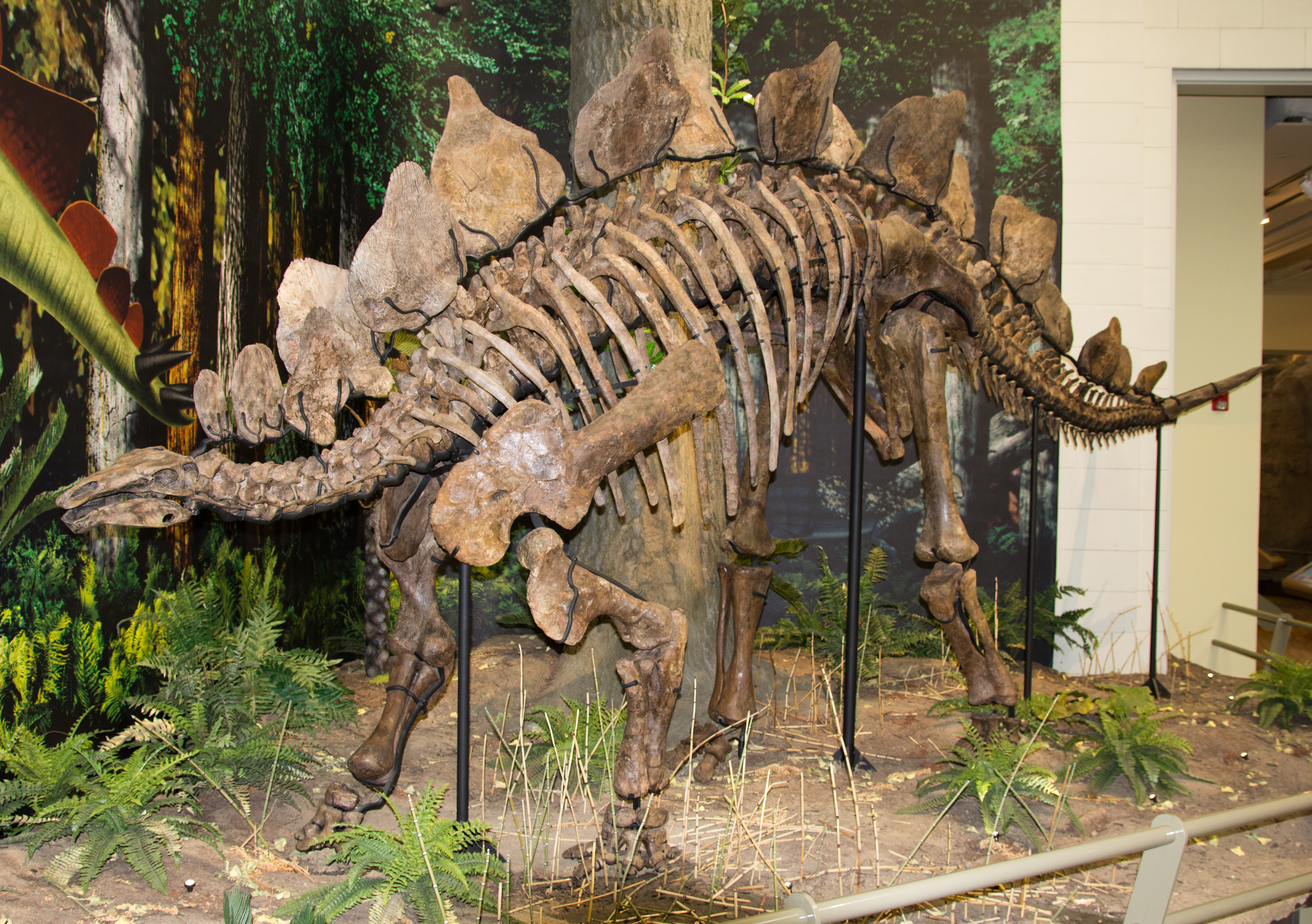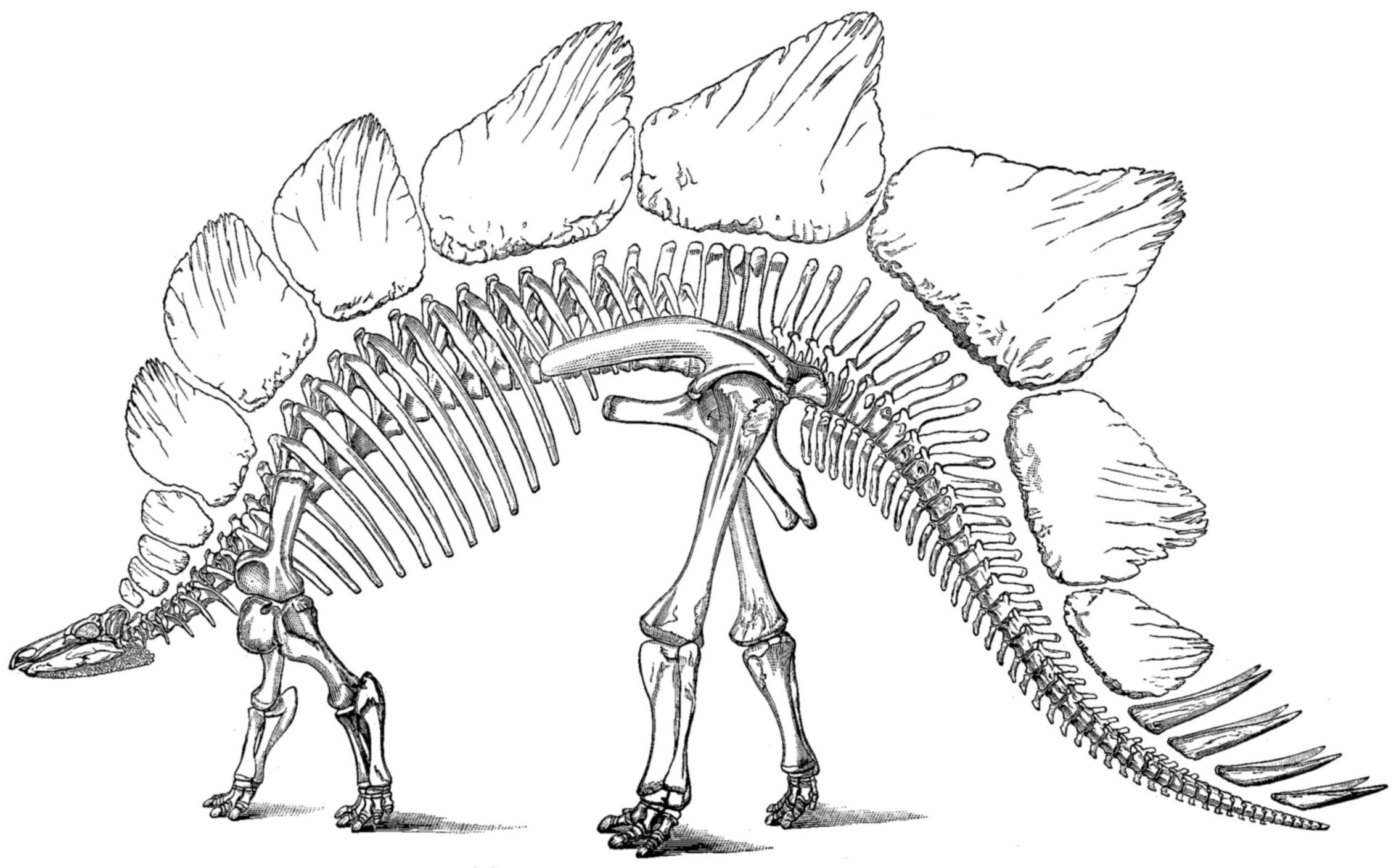 |
| Mounted skeleton of Stegosaurus ungulatus at the Carnegie Museum. The tail, plate, and spike arrangement have been updated in this mount to reflect current thinking following the study by Carpenter (1998). Photo by Perry Quan, CC-By-SA 2.0. |
Interpretation of the life appearance of stegosaurs has changed several times since they were discovered by O.C. Marsh in 1877. The first stegosaur fossil (belonging to the species S. armatus) were found near the town of Morrison, Colorado, but the specimen was disarticulated and only a few of the plates were preserved. Initially, Marsh thought that these plates played flat along the animal's back, forming a sort of turtle-like shell, or like the tiles on a roof (hence the name Stegosaurus, which means "roofed lizard"). Marsh also initially believed that stegosaurs were aquatic, due to this turtle-like appearance, but also that they would have walked on two legs on land.
By 1880, Marsh had studied the specimen further and changed some of his initial conclusions. He reversed his stance on the lifestyle of stegosaurs, recognizing them as land-living animals that were too heavy to have walked mostly on two legs (though he thought they could probably rear up on two legs when necessary). Marsh's recognition that the bases of the plates were asymmetrical also led him to propose for the first time that they stuck upright out of the back. He suggested that there were multiple rows of vertical plates covering the back.
 |
| Marsh's original 1890s restoration of Stegosaurus. |
Marsh died in 1899, but the job of preparing and interpreting his stegosaur specimens continued. In 1910, R.S. Lull examined the known specimens of Stegosaurus with the aim of solving the question of plate arrangement in order to produce the first-ever museum mount for the Yale Peabody Museum (which is still there unaltered, Marsh's eight spikes and all). Lull concluded that the double row of paired plates was correct, and that the plates were relatively widely spaced, above the top of the rib cage. This interpretation of Stegosaurus is probably the most famous, and the one that found its way into mid-20th century pop culture.
Charles W. Gilmore revised this interpretation only a few years later, when preparation of Marsh's S. stenops specimen was finally completed. Gilmore used the specimen to argue for an alternating, rather than paired, double row of plates, situated close together on the spine. This interpretation was used in several mid-20th century mounted skeletons, including the Carnegie Museum's and the American Museum of Natural History's. The latter remained unchanged during the dinosaur hall renovation of the early 1990s and is still on display in its original form.
.jpg) |
| Mounted skeleton and model of Stegosaurus stenops at the AMNH. This mount retains the posture and armor arrangement suggested by Gilmore in 1914. Photo by InSaphoWeTrust, CC-By-SA 2.0. |
 |
| Czerkas' 1987 Stegosaurus model showing raised neck and tail, with single row of plates. From Dinosaurs: A Global View, originally posted at Love in the Time of Chasmosaurs by Marc Vincent. |
The book was full of photos of Clerks' incredible dinosaur sculptures, including his own brand new interpretation of Stegosaurus. Czerkas portrayed Stegosaurus with huge plates (extended significantly by keratin, which was unusual in art at that time) arranged in a single row along the very peak of the back, but deflected slightly from side to side in an alternating fashion, and with a high, flat back, horizontal tail, and a slender neck held in a high, upright position. The new look of Stegosaurus was so revolutionary it was the subject of a fairly lengthy piece in The New York Times - "A Revisionist's View of Stegosaurus" by John Noble Wilford, August 1st, 1986 (several months before the publication of Bakker's The Dinosaur Heresies). Czerkas' radical new view of Stegosaurus was the one repeated in any forward-thinking dinosaur books during the 1990s, and rubbery plastic version based on Czerkas' sculpture was the first Jurassic Park toy I bought when it was released ahead of the movie in 1992 or '93.
 | |
|
About those spikes...
Richard Owen suggested as early as 1875 that the spikes often associated with dinosaurs were outgrowths of the wrist and used for defense. Marsh followed this interpretation in his initial description of Stegosaurus, but since there were more than two spikes, he guessed that the remainder must have been arranged along the forelimb. He discarded this idea when he found the first articulated stegosaur arm. Marsh later found enough specimens with the spikes near the tail that he concluded that must have been their natural position, and even began drawing distinctions between species and sexual morphs based on number or presence of tail spikes. The assumption based on his 1891 skeletal was that the spikes pointed upright. This was followed by later scientists, though no explanation or detailed rationale was ever given.
Carpenter (1998) re-examined the spikes, again because of the need to re-mount a museum specimen, and concluded that the spikes actually pointed posteroleterally (out and to the rear) based on several lines of evidence, including the alignment of grooves on their bases with the vertebrae in articulated skeletons having to be re-arranged to achieve an upright orientation.
How did they move?
Carpenter (1998) notes several times that the staggered rows of plates would have severely lowered lateral mobility. The body and tail simply would not have been able to move much without the plates coming apart from the vertebrae (see diagram of the tail above). So how could Stegosaurus move at all, let alone swing that tail far enough to the side to hit anything? Carpenter himself offers a partial solution: The skin covering the back must have been incredibly thick, and the plates anchored and buried pretty deep inside fibrous soft tissue. (This is contrary to some Renaissance-era suggestions by Bakker that the plates were somehow attached to the muscles, allowing them to be flexed up and down). The plates were anchored in tough, fibrous skin up to at least the bottom third of their height (Galton, 2012). As Carpenter notes, the fact that the plates were anchored in a thick layer of skin would have allowed the skin and plates to slide relative to the underlying bone and musculature, which should have increased overall mobility.
Below are two in-progress rough drafts showing possible extremes in range of motion (my own hypothesis based on the above info) for the neck and tail of Stegosaurus. Note that these depict two different species: S. ungulatus (top) and S. stenops (middle and bottom). Also note the lateral spike arrangement, and the degree to which the plates are buried in skin.
 |
| Sophie the (Czerkas-style?) stegosaur. |
- Carpenter, K. (1998). "Armor of Stegosaurus stenops, and the taphonomic history of a new specimen from Garden Park Colorado". The Upper Jurassic Morrison Formation: An Interdisciplinary Study. Part 1. Modern Geol. 22. pp. 127–44.
- Galton, P.M. (2012). "Stegosaurs". Pp. 483-504 in Brett-Surman, M.K., Holtz, T.R. Jr., and Farlow, J.O. The Complete Dinosaur - Second Edition. Bloomington: Indiana University Press.
- Taylor, M.P. (2014). "Quantifying the effect of intervertebral cartilage on neutral posture in the necks of sauropod dinosaurs." PeerJ, 2:e712.
- Taylor, M.P. and Wedel, M.J. (2013). "The effect of intervertebral cartilage on neutral posture and range of motion in the necks of sauropod dinosaurs." PLoS ONE, 8(10):e78214.
- Taylor, M.P., Wedel, M.J., and Naish, D. (2009). "Head and neck posture in sauropod dinosaurs inferred from extant animals." Acta Palaeontologica Polonica, 54(2):213–220.



May I recommend this:
ReplyDeletehttp://link.springer.com/article/10.1007%2Fs00015-010-0024-2
Carpenter's anorexic stegosaur is nonsense! The plates would have to be glued to the bone to block motion that much, but neural spines in extant reptile tails usually don't reach the surface. So you'd have to embed the plates really deeply.... nope, not going to work.
"Initially, Marsh thought that these plates played flat along the animal's back, forming a sort of turtle-like shell, or like the tiles on a roof (hence the name Stegosaurus, which means "roofed lizard"). Marsh also initially believed that stegosaurs were aquatic, due to this turtle-like appearance, but also that they would have walked on two legs on land."
ReplyDeleteAmazing! And:
"... that the spikes often associated with dinosaurs were outgrowths of the wrist and used for defense. Marsh followed this interpretation in his initial description of Stegosaurus, but since there were more than two spikes, he guessed that the remainder must have been arranged along the forelimb."
That is fascinating! Do you have the references for these early interpretations of Marsh?
Also: I'm struggling to buy the idea that the bottom third of the plates was buried in skin. Surely the pretty uniform vascularisation across all the bony plate suggests that all of it was elevated above the body?
Mike:
DeleteCarpenter mentions these old interpretations by Marsh in his 1998 paper. It looks like Marsh's opinion about aquatic but bipedal is cited to Marsh 1880 and 1881, "Principle characters of American Jurassic dinosaurs" III & IV, though I don't seem to have access to those original papers.
As reported by Carpenter, Owen (1875) suggested dinosaur spikes were "carpal appendages", which Marsh noted for Stegosaurus in his 1877 description of S. armatus, "A new order of extinct Reptilia (Stegosauria) from the Jurassic of the Rocky Mountains."
As for the lower third of the plates being embedded in skin, that comes directly from Galton 2012, but it's an offhand statement with no real support (Galton says its based on surface markings, I suppose not necessarily the vascularization). Maybe Heinrich can speak more to this based on his work on Kentrosaurus...?
Is ungulatus the same as armatus now or am I wrong in that?
ReplyDeleteSorry for such a late reply! Armatus and ungulatus were synonymized by some workers in the early 2000s, however armatus is now generally considered a nomen dubium (including by some of those same authors). S. stenops was made the type species of Stegosaurus in 2013 by the ICZN due to this.
DeleteGalton (1990; see also Galton & Upchurch 2004) listed S. ungulatus as a synonym of S. armatus, but Carpenter & Galton (2001) considered S. ungulatus valid because most of the S. armatus holoype was largely unprepared. For a long time, S. ungulatus was though to have had four pairs of spikes, but maps of Reed Quarry 12 (lectotype locality of S. ungulatus) refute this notion by showing the spikes partly scattered across the quarry (Carpenter and Galton 2001, fig. 4.11).
DeleteCarpenter, K., and Galton, P. 2001. Othniel Charles Marsh and the myth of the eight-spiked Stegosaurus. In: K. Carpenter (Ed.), The Armored Dinosaurs. pp. 76–102. Bloomington, Indiana University Press.